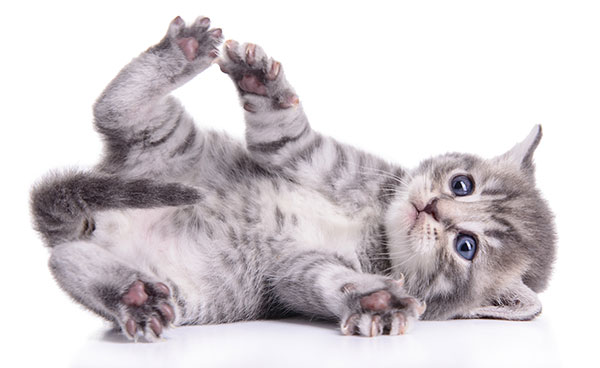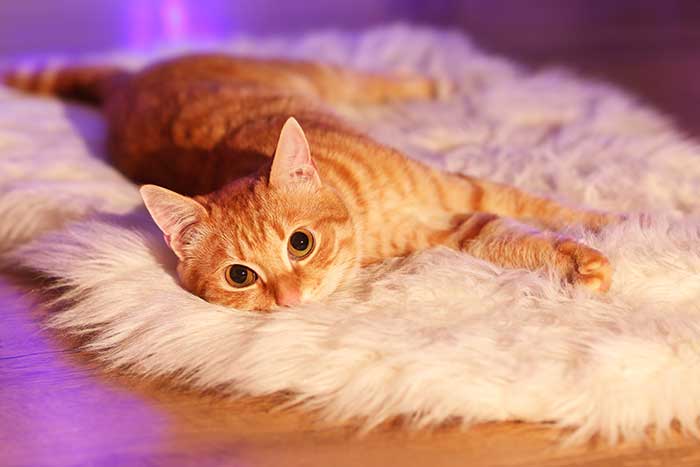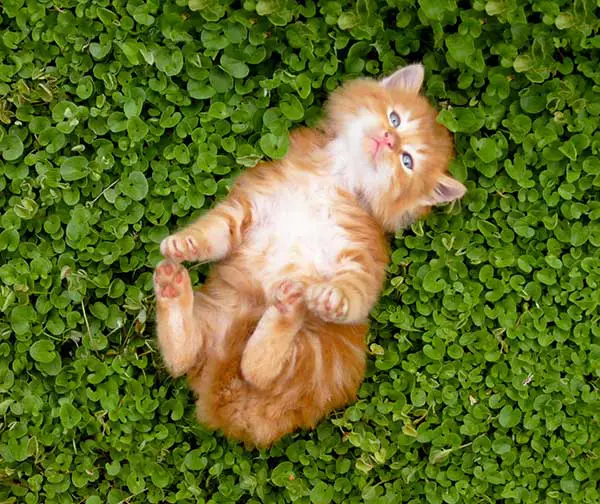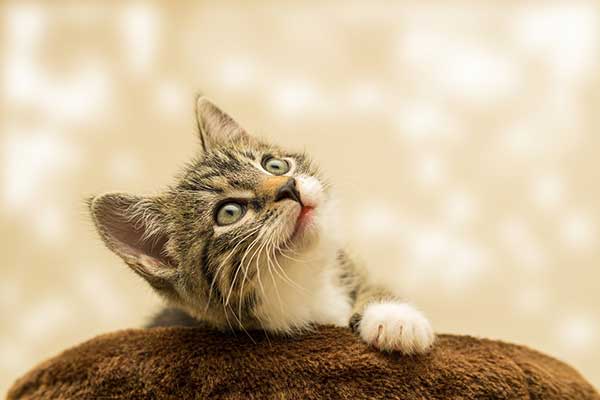Many pet parents have been conditioned to believe that dogs are the only animals that chase their tails. However, cats also do chase their tails, albeit less common than dogs. In fact, tail-chasing (also known as whirling) is generally common among predatory animals.
For many cat owners, tail chasing is often fun to watch. But as a responsible pet parent, it’s also important to understand some of the reasons that might trigger this behavior. And that brings us to the question, ‘why do cats chase their own tails?’
To answer this question conclusively, you’ll need establish the frequency with which your feline friend chases his own tail. If the behavior happens once in a while, it could mean that the cat is simply excited or bored. But if it happens every so often, then there could be an underlying medical condition.
All in all, it’s always prudent to visit your vet for more insights. That will help to rule out the possibility of any medical triggers.
Read on to uncover all the possible reasons why cats whirl and what you can do to stop the behavior.
Table of Contents
What Does It Mean When A Cat Chases Its Tail?
It’s not unusual to come across a cat owner wondering, ‘why does my cat chase its tail?’
As we’ve just pointed out, there are a number of reasons that could cause your feline friend to chase after her own tail.
The following are some of the common triggers of whirling among cats;
1. A form of play
One of the primary reasons many animals chase their tails is that it’s a form of play for them. This is usually more common among young predators.
So, maybe you’ve always wondered to yourself, ‘why do kittens chase their tails?’
Well, like all predatory animals, kittens generally chase their tails during playtime. Whirling among kittens is simply a great way to have fun.
Some experts also believe that since kittens are less intelligent than mature cats, they may not already know that their tails are attached to their bodies. To them, the tail is a hanging piece of toy that should be played with.
However, note that even mature cats can whirl when excited.
2. Predatory instincts
Cats are predatory animals. Much as we’ve domesticated them for thousands of years, our feline friends have retained much of their predatory drive.
As a predator, a cat will readily attack anything and everything that gets uncomfortably close to it, especially things that move. That ranges from other cats and hamsters to your shoe strings, long hair, etc. In the eyes of a cat, anything that moves is fair game.
The fact that a cat’s tail is ever in a state of motion makes it a perfect target for chasing.
When predatory instincts is the reason for whirling, you may also observe a tendency in your cat to go after other cats’ tails.
So, perhaps you’ve always wondered, ‘my cat is chasing another cat’s tail, what could be the reason?’ Well, the most plausible reason is that your cat’s predatory drive kicks in at the movement of another cat’s tail.
However, excitement and aggression could also cause your cat to chase another cat’s tail. And it shouldn’t be difficult to tell what the trigger is. All you need to do is watch the cat’s body language.
If your kitto is chasing his housemate’s tail out of excitement, you’ll notice that the cat jumps or rolls around. His ears may also be perked.
In the case of aggression, you’ll realize that the cat’s ears are folded back into the head. Other signs of aggression include growling or snarling, accompanied by tail flicking.
Either way, it’s important to watch the cats closely to ensure that they don’t harm one another. That’s especially if the animals are going after each other’s tails out of aggression.

3. Anxiety
Anxiety is another possible reason why cats may go after one another’s tails. This mostly happens when a cat is in a state of panic.
Some of the common causes of anxiety in cats include unsettling sounds like fireworks or cars speeding on the freeway, certain smells like the pheromones of other cats, or frightening sights like that of a large dog.
4. Boredom
Like humans, cats also get bored from time to time. Boredom is most common among elderly cats who generally spend too much of their time withdrawn from the rest of the pack.
Loneliness can also trigger boredom. This is usually a problem among cats who are abandoned for extended durations, but without enough toys to keep them physically and mentally stimulated while their owners are away.
Regardless of the cause, boredom can make your cat resort to all manner of aberrant behaviors. That includes chasing her own tail.
Last update on 2025-02-10 / Affiliate links / Images from Amazon Product Advertising API
5. Attention-seeking behavior
Cats are attention-craving animals. And a cat that craves attention can turn to the most absurd behaviors, one of which is whirling.
Now, there are numerous reasons why your cat might decide to chase her own tail in an attempt to get your attention.
Maybe you’ve not been petting or playing with your feline friend lately. Or perhaps your kitto has spotted a treat in the kitchen shelves and she feels you should hand it to him. In rare cases, a cat may chase her tail as a way of drawing your attention to an imminent danger.
The onus is on you to figure out whatever your cat is trying to communicate and respond appropriately.
6. Underlying medical condition
Even after ruling out all the above reasons, you might discover that your cat still chases his tail. That may get you wondering, ‘why is my cat chasing his tail yet he isn’t bored or excited?’
While tail chasing may be perfectly normal behavior, it could also be indicative of an underlying illness. Separation anxiety is the most common medical condition that could trigger whirling in cats.
As the name implies, separation anxiety is a mental condition that occurs when an animal is separated from his owner for extended durations. The disease is common among cats whose owners work or study for long hours.
The most common symptoms of separation anxiety include restlessness you’re about to leave the house and overly-excited greetings whenever you come back home. Tail chasing is also a signature symptom of cats with separation anxiety.

Other signs to watch out for include;
✔ Excessive vocalization, including meowing, crying, and moaning,
✔ Excessive self-grooming,
✔ Destructive behavior, such as excessive scratching, pawing, digging, or chewing,
✔ Pacing,
✔ Escaping behavior,
✔ Unusual feeding habits, such as eating too fast or not eating at all,
✔ Unusual bowel and/or bladder behavior, including eliminating in inappropriate places.
Besides separation anxiety, the following are other medical conditions that may cause your cat to chase his own tail;
a. Allergies
Your cat’s tail may itch following exposure to substances that the cat is allergic to.
Common allergies include certain foods like onions and raisins, inhalants like molds and pollen, certain medications, and certain fabric.
Generally, you’ll know that your cat is chasing his tail as a response to an allergy if the animal also exhibits the following symptoms;
✔ Discoloration of the fur
✔ Bald spots
✔ Sudden, inexplicable abrasions
✔ Inflammation
✔ Excessing licking and grooming
- EASY TO USE, IMPACTFUL RESULTS: Collect a sample, package it up, and send it securely back. Just register, swab, return with the...
- MOST COMPREHENSIVE BREED & TRAIT: Our test distinguishes over 20+ distinct breeds and 50+ trait markers with the most...
- SCREEN FOR 40+ GENETIC DISEASES: Get peace of mind by screening for 64 health markers associated with 43 diseases for which your...
Last update on 2025-02-11 / Affiliate links / Images from Amazon Product Advertising API
b. Fleas
Fleas tend to live just above the base of a cat’s tail as well as on his butts.
Flea bites can be unbearably painful for a cat and might trigger excessive grooming, making the animal chase his tail.
c. Stud tail
Also known as supracaudal gland infection, stud tail refers to an infection that usually occurs due to overactive sebaceous glands located at the base of a cat’s tails. Sebaceous glands are glands that secrete oils intended to soften and moisturize an animal’s skin.
However, overactive sebaceous glands may result in the production of too much oils, which end up accumulating at the base of a cat’s tail. The excess oil may irritate the cat’s tail, causing the animal to chase after his own tail to groom it.
Stud tail is typically common in intact male cats. The condition usually manifests as bald spots, blackheads, red bumps, or foul order at the base of a cat’s tail. If not treated urgently, stud tail might result in full-blown infection.
d. Tail soreness or infection
A cat’s tail may become sore or infected if the cat has been in fights with other cats or even other animals, particularly fights which result in tail bites and scratches.
Open tail wounds can be uncomfortably painful for your kitto to deal with. As such, the animal may try to go after these wounds to lick them, ending up chasing his own tail.
When these wounds start to heal, they stop being painful and start getting itchy. As a result, the cat chases his tail to try and scratch it.
Besides soreness, infected tail wounds may also cause your cat to whirl. That’s especially if the wounds are infected by bacteria which end up causing pain and itchiness.

e. Feline Hyperesthesia
According to some experts, feline hyperesthesia is a form of feline schizophrenia. One of the common symptoms of the disease is unreasonable fixation with the tail, where a cat consistently swishes or chases his tail.
Also known as rolling skin disease, hyperesthesia refers to a condition where a cat becomes highly sensitive to touch. A subtle touch on a hyperesthesic cat may result in the animal acting as though he’s in great pain.
In many cases, cats with hyperesthesia have been shown to chase their tails and run around the home while screaming. The condition may also be accompanied by fits of seizures.
f. Impacted Anal Glands
The impacting of a cat’s anal glands may feel painful to poop. That may also cause the animal to go after his tail.
How to Stop Your Cat From Chasing His Tail
Right off the bat, it’s important to avoid yelling at your cat or otherwise reacting in a manner that might inadvertently motivate him to continue chasing after his tail. That includes, among other things, not giving the animal any attention, food, or treat.
The goal is to help him stop the behavior, not reinforce it.
It’s also important to find the root cause of the problem. The following questions might go a long way in helping you to uncover the underlying reason why your cat chases his tail;
How old is the cat?
Kittens tend to chase after their tails more often than older cats. And in most cases, they do so out of excitement.

When does the cat take to this behavior?
If your cat only chases his tail whenever you’re about to leave the house or when you return home after a long day at work, then you might be dealing with a case of separation anxiety.
Similarly, if the animal begins chasing after his tail whenever the neighbor’s cat visits your house, that could indicate aggression or curiosity.
What other symptoms accompany the behavior?
It’s paramount that you document all the other symptoms that a whirling cat demonstrates. That may clue you in on the exact triggers for the behavior.
For instance, if your cat’s bums are visibly bruised and the animal happens to be chasing after his tail, you can attribute the whirling behavior to tail soreness or infection.
- A tasty & body nourishing treat for cats & dogs - Essential fatty acids for a healthy coat.
- Healthy, powerful Omega fatty acids - This premium Salmon Oil is rich with Omega-3 & Omega-6 fatty acid from EPA & DHA, that can...
- Help your pet stay looking great - The rich Omegas in Salmon Oil are a dog health supply to nourish skin and coat and keep your...
Last update on 2025-02-11 / Affiliate links / Images from Amazon Product Advertising API
What’s your cat’s general disposition when he’s chasing his tail?
Last but not least, observe your cat’s temperament and disposition keenly while he chases his tail.
Is the cat happy and playful? Does he howl, growl, or exhibit other signs of aggression? Does the animal limp or run in a manner likely to suggest he’s in pain?
Once you’ve identified the root cause of the problem, the next logical thing to do is take an appropriate course of action.
If your cat whirls out of excitement, boredom, anxiety, or predatory instincts, you may consider getting him enough toys.
Toys are a major positive distraction. They can keep a cat stimulated and prevent him from developing aberrant behaviors, such as whirling. While choosing the right toys for your kitto, insist on interactive ones, such as ball launchers, wand toys, and puzzle toys.
- Stack & Sturdy Construction: This cat toy is made of ultra-strong and tear-resistant PP that stands up to crazy cat scratcher...
- Spinning Balls Keep Cats Busy: The cat toy stimulates your cat’s senses and hunting instincts, this will increase their...
- Keep Away Lonely: This toy provides hours of exercise & self-amusement for health care and elimination of boredom and pet...
Last update on 2025-02-10 / Affiliate links / Images from Amazon Product Advertising API
Also, avoid drastic routine changes as that may trigger anxiety and cause your cat to whirl. It’s okay to move homes or repaint your kitto’s sleeping area. However, go slow on these projects to allow your cat ample time to familiarize himself with the routine changes.
If your cat chases his tail in a desperate attempt to draw your attention to something, be keen to learn what the animal is trying to communicate. It could be that you’re not petting, grooming, exercising, or feeding him to his satisfaction. Basically, take note of whatever the animal is trying to draw your attention to.
Lastly, in the case of an underlying medical condition, your best bet would be to visit your vet. The vet will conduct a proper diagnosis and determine the illness your cat is suffering from before prescribing the right medication.

So, Why Does My Cat Attack Its Own Tail?
As a cat owner, it’s natural to wonder, ‘why does my cat chase her tail?’
Well, as we’ve highlighted throughout this post, there are numerous reasons that could cause your feline friend to whirl.
In most cases, the behavior is perfectly normal and can be dealt with effectively by the cat owner. But on rare occasions, whirling could necessitate a visit to the pet.
The onus is on you, as the cat owner, to monitor your cat carefully and establish the real reasons why the animal chases his tail.
Checkout Our Favorite Cat Products
1. Best Online Course For Cat Parents
Our favorite: The Cat Language Bible (How to Finally Understand And Speak to Your Cat) – A new form of cat to human communication that many cat owners have dreamed about… but few have actually thought possible.
2. Best Immune Support For Cats
Our favorite: Tomlyn Immune Support – Best Supplement for Cats and Kittens.
3. Best Cat Treats
Our favorites: LIFE ESSENTIALS All Natural Freeze Dried Chicken And Sheba Meaty Tender Sticks – Both are Great.






